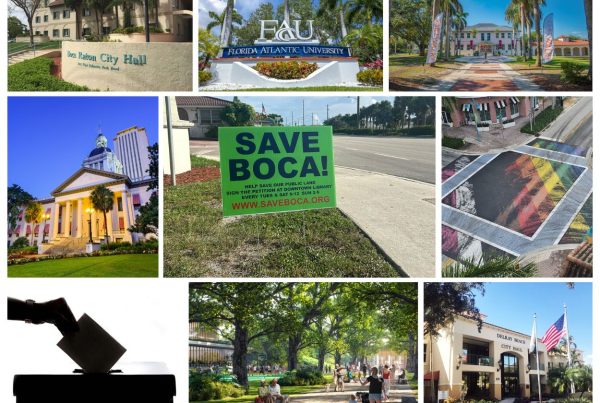Old School’s new plan

Many details remain, but Delray Beach is in a much happier place regarding Old School Square than the city was two years ago.
An architect seemed ready to turn the site–which includes the Crest Theater, the Cornell Art Museum, and Fieldhouse and the Pavilion—into something resembling the plaza of a European city. It was way too much, especially since residents already were complaining about all the events that left Old School Square trampled. The city commission addressed that with a new policy, and discussion about Old School Square continued.
This week, the commission and the board of the community redevelopment agency saw renderings and numbers for the updated master plan. It’s ambitious, costing nearly $12 million in four phases. The last phase is a covering for the Pavilion, which essentially would turn it into an amphitheater. The first phase, at roughly $500,000, would involve new signs, better lighting for the Cornell Museum and moving the location of the new $800,000 Christmas tree.
Mayor Cary Glickstein called the plan “the product of nearly two years of community dialogue.” Though he expects changes, Glickstein said the plan “when fully implemented–both the physical and programming improvements—will give the city a 21st-century, culturally-inclusive, public park surrounding some of the more historically important buildings in South Florida.”
Commissioner Mitch Katz noted, correctly, that the previous plan came out after just one public meeting. This version represents “a community effort.” Katz doesn’t agree with all of the elements—the amphitheater “might be a little overkill”—but he acknowledged and will support the public’s preferences. Katz added that Old School Square Director Rob Steele believes that there is philanthropic support in Delray for the plan.
Commissioner Jim Chard “very much” likes the plan, but wants to know, “How do we make it work?”
Chard wondered if there would be “activities every day, or just big events?” He noted that the Wednesday drum circle is self-sustaining. What subsidies might be necessary and proper for other programming? Could the city and CRA recoup some of the amphitheater cost from new revenue, if private donors can’t finance construction? Should the city allow alcohol sales?
“I don’t think there are necessarily definitive answers to these questions,” Chard said, “but they should be discussed in a narrative accompanying the renderings.”
Though Delray Beach wants Old School Square to be vibrant, the city also wants it to be calming. As Glickstein put it, “Just plain grass and shade trees and places to sit and just watch the clouds go by isn’t architecturally compelling, but it’s one of the common themes expressed as to what people wanted in their park.”
In an email, Steele also praised the “comprehensive process” that led to the plan. “The absence of objections from participants in recent public meetings on the park plan,” he said, “is indicative of the broad-based support that the process has achieved.
“Old School Square is strategically, aesthetically artistically, and financially one of the more valuable 5-acre parcels in Palm Beach County. The master plan affords Delray Beach the opportunity to make a bold statement defining who we are and who we want to be. Fortune favors the bold. It makes abundant sense for our community to marshal its resources to see this dream become a reality with all deliberate speed.”
Steele was hired in August 2015, a few months after the first plan met strong resistance. Taking more time, Steele said, “afforded the opportunity for cool minds to prevail on the ‘hot button’ aspects of the plan. To the casual observer, the process may appear to be a winding path, but the end product is of a singularly high quality.
“This thoughtful plan for Old School Square is easy to visualize and embrace, and it will, on many fronts, serve to provide hope for a bright and balanced future for this important corner of Delray Beach.”
Chabad lawsuit persists
The First Amendment lawsuit over Chabad East Boca will continue.
Plaintiffs Katie MacDougall and Gerald Gagliardi filed notice last week that they would appeal the latest ruling that dismissed their lawsuit against the city. U.S. District Judge Kenneth Marra twice has dismissed claims from the plaintiffs, who are Christians, that Boca Raton conspired with the Jewish congregation to allow its new place of worship near their homes in the Riviera neighborhood. Art Koski, who represents MacDougall and Gagliardi, said the plaintiffs’ brief is due on May 31.
Art museum expansion on campus?
Include the Boca Raton Museum of Art among the parties interested in plans for the city’s downtown campus.
One idea for the roughly 30 acres around East Palmetto Park Road and Northwest Second Avenue is a performing arts center that presumably might replace the Mizner Park amphitheater. The museum adjoins the amphitheater on the park’s northwest corner.
If that happened, the representatives said, the museum might want to expand onto some of the amphitheater property while preserving as much green space as possible. One representative said such a move could be “transformational” for the museum.
A public input session on the campus will take place in May. Council members also want the city to get moving on a downtown parking garage, which could be part of the new campus east of Second Avenue. All of which confirms that the council probably will sell the western golf course. The sale could provide $70 million-plus that could go toward the campus.
Mayor Susan Haynie especially has complained that cities like Pembroke Pines in southwest Broward County are designing and building new campuses while Boca Raton City Hall reeks of 1970. In her role as president of the Florida League of Cities, Haynie recently attended the opening of Pembroke Pines’ spiffy new digs. Haynie might envision an even better one in Boca as her legacy project.
Boca Regional garage
I reported Tuesday on the favorable vote that Boca Raton Regional Hospital’s proposed parking garage got from the city’s planning and zoning board. The ordinance to allow the garage will be introduced at the May 9 city council meeting, with the public hearing on May 23.
West Palm facing building height issue
In my package of stories about downtown Boca Raton that appeared in the magazine’s April edition, I debunked the idea that the city is turning into “another Fort Lauderdale.” West Palm Beach just offered up another example of why, for all the complaints about downtown development, Boca is not trying to give away the store.
Two decades ago, West Palm Beach voters restricted building heights on the downtown Flagler Drive waterfront to five stories. The issues behind the referendum were complicated, and the restriction might not have been the best response. Still, it’s on the books.
Now the Related Cos., wants to build a 25-story building called One Flagler in that area. The Palm Beach Post reported that the company proposed a 30-story tower last fall, but the city rejected the plan.
To recap, no building in downtown Boca Raton is taller than the allowed heights—100 feet under Ordinance 4035 and 140 feet under Ordinance 5052. Three years ago, Elad Properties proposed four condo towers on Mizner Boulevard that would have been roughly 200 feet above the limit for that area. As for One Flagler, the company touted the potential revenue and the reputation of the New York City-based architect.
The city council never considered New Mizner on the Green. The project since has become Mizner 200. Though it also has drawn criticism, Mizner 200 is nothing like One Flagler. Downtown Boca Raton has issues, but keeping a sense of perspective will help the city resolve those issues.
Correction
In my Tuesday post, I wrote that Crocker Partners believes that the Midtown area of Boca Raton could absorb 2,500 residential units and not generate new traffic even if a Tri-Rail station wasn’t built north of Boca Center. The correct number is 1,300 units.
Missed the last City Watch? Visit our Community/City Watch page for the latest posts, and subscribe to the magazine for the best coverage of Boca and beyond.







